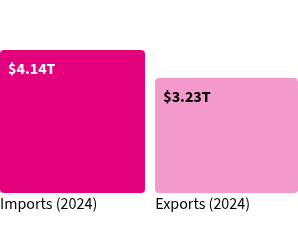What are tariffs and how do they work?
Tariffs are taxes paid by firms importing goods internationally. They are used as a tool to control global trade.
What is a tariff?
Tariffs, sometimes called duties or customs duties, are taxes on goods that are traded between nations. When goods cross the US border, Customs and Border Protection (CBP) collects tariffs based on the type of goods, their quantity, and which country they’re coming from.
Why do countries use tariffs?
Tariffs are a way for countries to control international trade. By artificially raising the cost of importing goods, tariffs can incentivize would-be importers to instead purchase goods from domestic sellers, potentially strengthening the local economy.
Politics can also play a role: governments can adjust tariffs to exert economic leverage over political rivals or retaliate against other tariffs or economic sanctions.
Tariffs also generate revenue for importing countries, though in developed countries and in today’s global economy, they tend to be used more to achieve foreign policy goals than financial ones.
Who pays for tariffs?
In a literal sense, companies that are importing goods from international trade partners pay the tariff fees to CBP at the port of entry within 10 days. When the US raises tariffs, US companies importing goods are responsible for paying those tariffs.
But as an economic policy, tariffs have implications beyond the money exchanged at the border.
According to the Bureau of Labor Statistics (BLS), this indirectly raises domestic prices on goods as supply-and-demand forces often push the burden onto consumers in the importing country.
How do tariffs impact prices?
In a supply-and-demand economy, when supply of a certain commodity goes down, prices tend to go up, because there is less of the commodity available to meet the demand. Tariffs, like all taxes, drive an economic “wedge” between what an importer pays and what an exporter receives as payment.
Tariffs, by design in some cases, lower competition on domestic sellers. If a buyer needs to pay more to import a good, more buyers may buy domestically or from another import partner, which means these sellers can increase prices. Artificially disincentivizing buyers from participating in international markets effectively shortens the global supply.

In 2009, increased tariffs on tires imported from China led to a 67% drop in the volume of Chinese tire imports. As a result, US buyers started purchasing more from domestic sellers and other international sellers, who could sell for higher prices with their Chinese competition burdened by the tariff. The cost was passed on to consumers: The BLS estimated an additional cost of $1.1 billion for domestic consumers as a result of the tariff.
How much revenue do tariffs generate?
The US brought in $77 billion in tariffs in 2024, according to the Congressional Budget Office (CBO). This was down from a historically high period after revenue from tariffs more than doubled from 2017 to 2022.
This total accounted for 1.6% of federal revenue. Since the 1960s, duties have not made up more than 2.0% of total revenue.
The CBO also calculates duties as a share of total gross domestic product. Since the 1960s, customs duties have amounted to between 0.2% and 0.4%.
Who is in charge of tariff policy?
The Constitution designates Congress as the authority over tariffs. Prior to the 1930s, Congress set most tariffs by passing legislation. Since then, it has delegated much of that authority to the president through legislation, authorizing the White House to adjust rates.
How are tariffs established?
As of October 2024, the average tariff rate is 3.4%, but it varies broadly based on the product, cost, quantity, and relationship between the importing and exporting countries. Tariffs can be issued as a percentage of the total bill of imports or as a fixed cost per unit.
The International Trade Commission (USITC) maintains these rates in a system called the Harmonized Tariff Schedule, which details all existing trade agreements and 99 chapters’ worth of product categorization. CBP is tasked with enforcing the system.
How do tariffs vary by country?
A country’s tariff rates depend on its trade relationship with the US. The US is one of 164 member nations of the World Trade Organization (WTO), which has a framework for trade among its members. The WTO’s “most favored nation” rule maintains that an import tariff set by a member country on another member must apply to all members at the same rate. This was designed to establish a generally low-tariff, rules-based system.
There are some exceptions, though. Member nations are allowed to establish free trade agreements amongst themselves to reduce barriers on exports. They can also make exceptions to ease the burden on developing countries or respond to certain other trade practices.
The US has 14 free trade agreements with 20 trade allies to which the US sends about 40% of all exported goods.
How do tariffs vary by product?
The USITC’s Harmonized Tariff Schedule breaks products down into specifics. For instance, milks with different fat contents had different tariff rates for World Trade Organization exporters in 2024. Importers paid 0.34 cents per liter for milks with fat content at 1% or lower, and either 0.43 cents per liter or 1.5 cents per liter — depending on the quantity — for milks with fat content greater than 1% but not over 6%.
In the 2024 version of the yearly tariff data published by the USITC, there were nearly 13,000 distinct product categories.
Read more about global trade and get the data straight to your inbox with our weekly newsletter.
Keep exploring
Page sources
International Trade Commission
US Free Trade Agreement Partner Countries
